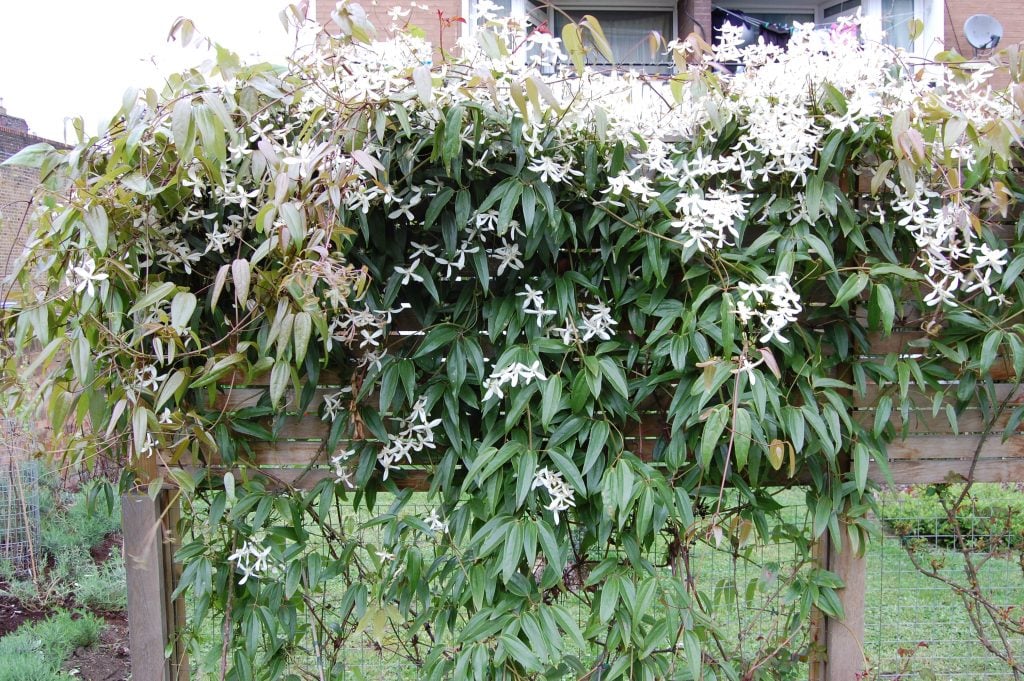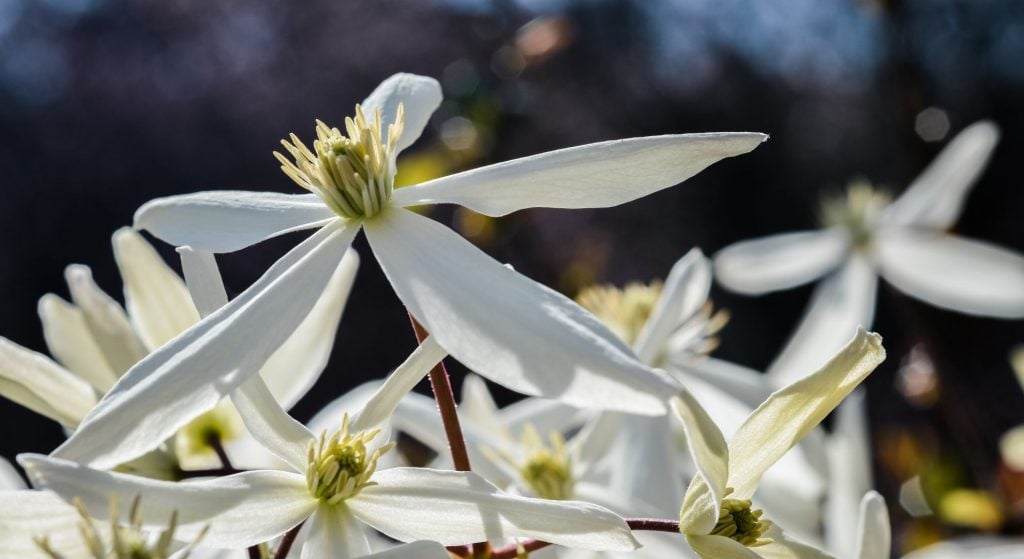Table of Contents
Whether you’re an experienced gardener or just starting out, learning about Clematis Armandii can be a rewarding experience that will enhance your gardening knowledge and give you a new appreciation for this lovely plant!
Clematis Armandii, also known as Armand clematis, is a gorgeous evergreen vine that is prized for its stunning, fragrant flowers and lush foliage. China has cultivated this plant for centuries because of its unique characteristics.
You will learn everything you need to know about growing and caring for Clematis Armandii in this article. From planting and watering to pruning and propagation, we’ll cover all the important aspects of cultivating this stunning vine. So, let’s dive in and discover the world of Clematis Armandii together!
Let’s start with knowing the much-needed background of Clematis Armandii!
What is Clematis Armandii?

Step into the world of Clematis Armandii, a botanical wonder that will mesmerize you with its delicate, fragrant blooms and lush foliage. This captivating evergreen vine is a sight to behold, with its stunning white or pink flowers that bloom in early spring and fill the air with their sweet scent. The plant’s glossy leaves provide a gorgeous backdrop for its vibrant blooms, making it a showstopper in any garden. Clematis Armandii’s vigorous growth and climbing habit add vertical interest to any outdoor space, creating a lush, green tapestry that will enchant you and your guests. Your garden will be filled with beauty and charm thanks to Clematis Armandii.
It grows in forests and along stream banks in China. Clematis Armandii is a flowering vine that is native to China. Père Armand David, a French missionary and plant collector, discovered it in the late 1800s. Clematis Armandii became popular in British gardens and is now grown all over the world due to an English plant collector named Ernest Wilson, who sent seeds and plants back to England.
Characteristics and Features of Clematis Armandii

| Appearance | A vigorous evergreen climber up to 6m (20ft) tall with glossy, leathery, dark green leaves that are ovate to lanceolate in shape and up to 10cm (4in) long. Produces masses of fragrant, white, star-shaped flowers in early spring. |
| Fragrance | A sweet, vanilla-like fragrance permeates the flowers on warm, sunny days, attracting bees and other beneficial insects. |
| Growing Conditions | Requires regular watering, especially during dry periods. It grows best in a sunny to partially shaded location with well-drained soil. |
| Uses | Having fragrant flowers, it is popular in cut flower arrangements and grows well on trellises, walls, and other supports. |
Key Points to Remember While Planting Clematis Armandii
1. When to Plant Clematis Armandii
Plant Clematis armandii in the spring or fall. The best time to plant is in the early spring before new growth begins or in the fall after the plant has gone dormant.
2. Choosing the Location for Clematis Armandii
To plant Clematis Armandii, you should choose a location that has full sun to partial shade and is protected from strong winds. The rule is simple, the plant should stay in the sun, while the head should be kept in the shade for the optimum growth of the plant.
3. Soil Requirements for Clematis Armandii
Plant Clematis Armandii in soil that is slightly acidic to alkaline and does not retain a lot of water. Before planting, amend the soil with compost or well-rotted manure. The plant prefers moist soil but not too wet or soggy soil, so water it evenly.
The plant requires nutrients, moisture, and well-draining soil to thrive.
How To Plant Clematis Armandii
- Dig a hole that is twice as wide and deep as the plant’s root ball, and mix in compost or well-rotted manure into the soil.
- After removing the plant from its container and loosening any tangled roots, place it in the hole and backfill it with soil, firming it gently around the plant.
- Water the plant thoroughly, and provide a trellis or other support for the vine to climb.
- Finally, apply a layer of mulch around the base of the plant to help retain soil moisture and suppress weed growth.
Watering and Fertilizing Clematis Armandii
1. How Often to Water Clematis Armandii
Watering your clematis twice a week is probably necessary if it is being grown in a pot. In order to prevent the soil from becoming soggy, ensure that the container has adequate drainage. But throughout the season, it ought to stay moist. Make sure the soil is moist to the top inch before watering.
2. Fertilizing Requirements for Clematis Armandii
It is recommended that you use a balanced fertilizer containing equal amounts of nitrogen, phosphorus, and potassium. Slow-release fertilizers or liquid fertilizers can be used, depending on your preference.
3. How to Fertilize Clematis Armandii
Application: Spread the fertilizer evenly around the base of the plant, avoiding contact with the stems and leaves. Water the plant thoroughly after applying the fertilizer to help it absorb the nutrients.
When to Prune Clematis Armandii
- Timing: Clematis Armandii should be pruned immediately after flowering, typically in late spring or early summer. This will give the plant time to grow new shoots for the following year’s flowering.
- Method: Clematis Armandii should be pruned lightly, removing only the dead, damaged, or overcrowded stems. Do not prune the plant too heavily, as this can reduce its flowering.
- Tools: Use sharp, clean pruning shears to make clean cuts and prevent the spread of disease.
- Training: As Clematis Armandii is a vine, it will need to be trained onto a support structure such as a trellis or fence. As you prune the plant, train the remaining stems to grow in the desired direction.
Tips for Maintaining Clematis Armandii
Clematis Armandii is a beautiful, evergreen vine that requires some specific care to thrive. To maintain this plant, you should water it regularly, fertilize it twice a year, prune it lightly after flowering, provide support for its growth, apply a layer of mulch, and keep an eye out for any pests or diseases that may arise.
When planting Clematis Armandii, choose a location with well-draining soil that is rich in organic matter and has a neutral to slightly alkaline pH. Provide the plant with full sun to partial shade and protection from strong winds. With proper care, your Clematis Armandii will reward you with beautiful flowers and lush foliage year after year.
Common Problems and Pests of Clematis Armandii
-
Aphids: These tiny insects can cluster on the stems and leaves of Clematis Armandii, causing distortion and curling of the foliage. They can be controlled with insecticidal soap or neem oil.
-
Spider mites: These pests are more common in hot, dry weather and can cause yellowing and webbing on the leaves. They can be controlled with insecticidal soap or neem oil.
-
Powderymildew: This fungus disease causes the plant’s leaves to develop a white, powdery coating. Good ventilation and avoiding overhead watering can help to prevent it. It is possible to remove and destroy infected leaves.
-
Stemrot: This disease, which can make the plant wilt and die, can develop in poorly drained soil. Well-draining soil and avoiding overwatering can help to prevent it.
-
Scaleinsects: These pests can resemble tiny, brown bumps on the plant’s stems and leaves. Neem oil or insecticidal soap are effective treatments for them.
Propagation of Clematis Armandii
Propagating of Clematis Armandii can be done by following these steps. Clematis Armandii can be propagated by layering or cuttings.
- For layering, choose a healthy stem and bend it down to the ground, making a shallow cut in the stem and applying the rooting hormone. Cover the cut with soil, anchor the stem, water regularly, and wait for roots to form.
- For cuttings, take a 6-inch cutting from a healthy stem in summer or early fall, remove lower leaves, dip the cut end in rooting hormone, and plant it in a well-draining soil mix. Cover with a plastic bag and place in a warm, bright location but out of direct sunlight. After a few weeks, check for roots and transplant them to a new location once they have formed.
- Use sterile tools when making cuts or taking cuttings to prevent disease.
- Keep soil moist but not waterlogged when propagating, and avoid extreme temperatures.
- Patience is key, as it can take several months for roots to form and new plants to be established.
Ready to Grow Your Clematis Armandii?
The Clematis Armandii is a stunning and popular plant choice for gardeners in the UK. It has evergreen leaves and fragrant white flowers that bring elegance and fragrance to any garden in the country. Here are some tips on how to grow and propagate Clematis Armandii in the UK if you follow them.
No matter if you buy it from a nursery, propagate it from cuttings, or layer it, this plant is easy to maintain and a great addition to any garden. Clematis Armandii is gorgeous and fragrant, so why don’t you plant it in your garden today?
Please share any questions or suggestions you may have about this subject in the comments section below.

![The Ultimate Guide to Taking Care of Clematis Armandii [UK] Clematis Armandii Plant Care & Growing Tips](https://www.thearches.co.uk/wp-content/uploads/Clematis-Armandii-Plant-Care-Growing-Tips.jpg)




1 Comment
My Armandii clematis seems to be wilting, the foliage is not a dark Green & has brown on the tips ?